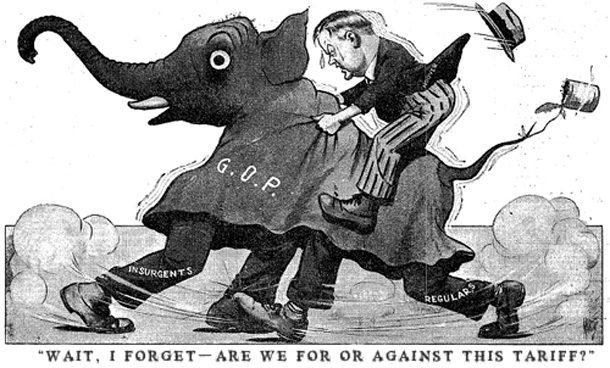Free Trade Shouldn’t Be a Litmus Test for Conservatism

According to a recent analysis in the New York Times, President Trump’s “isolationist” trade policy is “at odds with longstanding conservative orthodoxy about the benefits of free and open markets.” The reader is further told that the president is under pressure from his working-class base, which is obstreperously demanding that protectionist taxes be placed on imported steel and aluminum.
I say not so fast.
The Times presents the GOP base’s supposed impatience with free trade as a departure from almost sacred Republican beliefs, and free trade itself as a permanent conservative characteristic. Their evidence is that large corporations favor free trade while labor unions have generally been more protectionist.
But both assertions represent gross oversimplifications. Those who present free trade as a “conservative” position are skimming over whole chapters of the past. They conveniently overlook (or are totally ignorant of) the fact that well into the 20th century, American statesmen who could hardly be characterized as leftists—like Alexander Hamilton, Henry Clay, and William Howard Taft—were outspoken advocates of tariffs. So were Abraham Lincoln and his Republican supporters, who in 1860 intended to raise the existing tariffs of 1857 to a record high (and to the detriment of the agricultural South). Two of the most fateful increases in taxes on foreign imports, the Morrill Tariff of 1861 and the Smoot-Hawley Tariff of 1930, were the work of Republican congressmen. In 1930, a not-exactly-leftist president Herbert Hoover happily signed Smoot-Hawley, which may or may not have worsened the Great Depression that had developed the year before. President Eisenhower was also a known supporter of tariffs, which earned him criticism from free traders.
Moreover, a recent darling of the establishment, Republican President George W. Bush, imposed steep duties on imported steel in 2002. This steel tariff ranged from between 8 and 20 percent, depending on who was exporting and what was being exported to the U.S. Bush Jr. was compelled to act by the declaration of bankruptcy by 30 steel companies in the preceding decade; he kept the imposts he introduced in force until the end of the next year. Canada and Mexico were excluded from these tariffs because of the North American Free Trade Agreement (NAFTA). Still, it is hard to see how Trump’s attempt to extend tariffs to NAFTA signatories represents a radical deviation from the high steel tariffs of his Republican predecessor. By the way, there are permanent tariffs that exist for shoes and clothes, which neither national party is likely to touch.

In Europe, such non-leftists as Louis XIV, Frederick the Great, and Otto von Bismarck favored tariffs to protect the agricultural and commercial products of their countrymen. Up until the second half of the 18th century when Adam Smith and other critics of mercantilism began writing, it was generally assumed that all concerned European leaders would protect their commerce and infant industries by limiting imports and trying to increase exports. England practiced free trade in the 19th century principally because it was the most advanced industrial nation with the largest supply of credit. When these conditions changed before the First World War, the English government reverted to protectionism. This change in England’s fortunes and views about trade provided the theme of a famous book, The Strange Death of Liberal England, by George Dangerfield, which was published in 1935. Not surprisingly, it was the Tories who were accused of giving the death blow to English free trade.
It is not often mentioned—but should be, for the sake of accuracy—that the major advocates of free trade in the 19th century were radicals like John Bright, Richard Cobden, and James and John Stuart Mill. Such free traders believed in extending the suffrage to women, and in various mechanisms for breaking down national barriers. Although the goals of these radicals have become mainstream positions by now, in the 19th century they certainly were not. The English protectionists against whom the radicals fought, particularly over the Corn Laws that maintained tariffs on the import of foreign grain, were the landed Tories. Benjamin Disraeli rose to fame as a Tory leader by taking the losing side of what was then the English right.
Although I myself lean towards free trade (all things being equal), there is no historical reason to assume that this position defines traditional Republicanism or a conservatism. Such an assumption is a perfect example of what may be called “litmus test conservatism.” A particular position becomes “conservative” because the donor base of what calls itself the conservative movement want its beneficiaries to advocate for it. We are fully justified in questioning free trade as such a litmus test. That position has often been linked with the left, while protectionism has just as often been associated with both Republicans and the European right.
Paul Gottfried is Raffensperger Professor of Humanities Emeritus at Elizabethtown College, where he taught for 25 years. He is a Guggenheim recipient and a Yale PhD. He writes for many websites and scholarly journals and is the author of 13 books, most recently Fascism: Career of a Concept and Revisions and Dissents. His books have been translated into multiple languages and seem to enjoy special success in Eastern Europe.
Comments